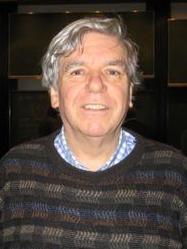Martin Neil Huxley | |
|---|---|
 Martin Huxley in 2008 | |
| Born | 1944 |
| Alma mater | University of Cambridge |
| Known for | Analytic number theory Sieve theory |
| Scientific career | |
| Fields | Mathematician |
| Institutions | University of Cardiff |
| Doctoral advisor | Harold Davenport |
Martin Neil Huxley FLSW (born in 1944) is a British mathematician, working in the field of analytic number theory.
He was awarded a PhD from the University of Cambridge in 1970, the year after his supervisor Harold Davenport had died. He is a professor at Cardiff University.
Huxley proved a result on gaps between prime numbers, [1] namely that if pn denotes the n-th prime number and if θ > 7/12, then
for all sufficiently large n.
Huxley also improved the known bound on the Dirichlet divisor problem. [2]
In 2011, Huxley was elected a Fellow of the Learned Society of Wales. [3]
